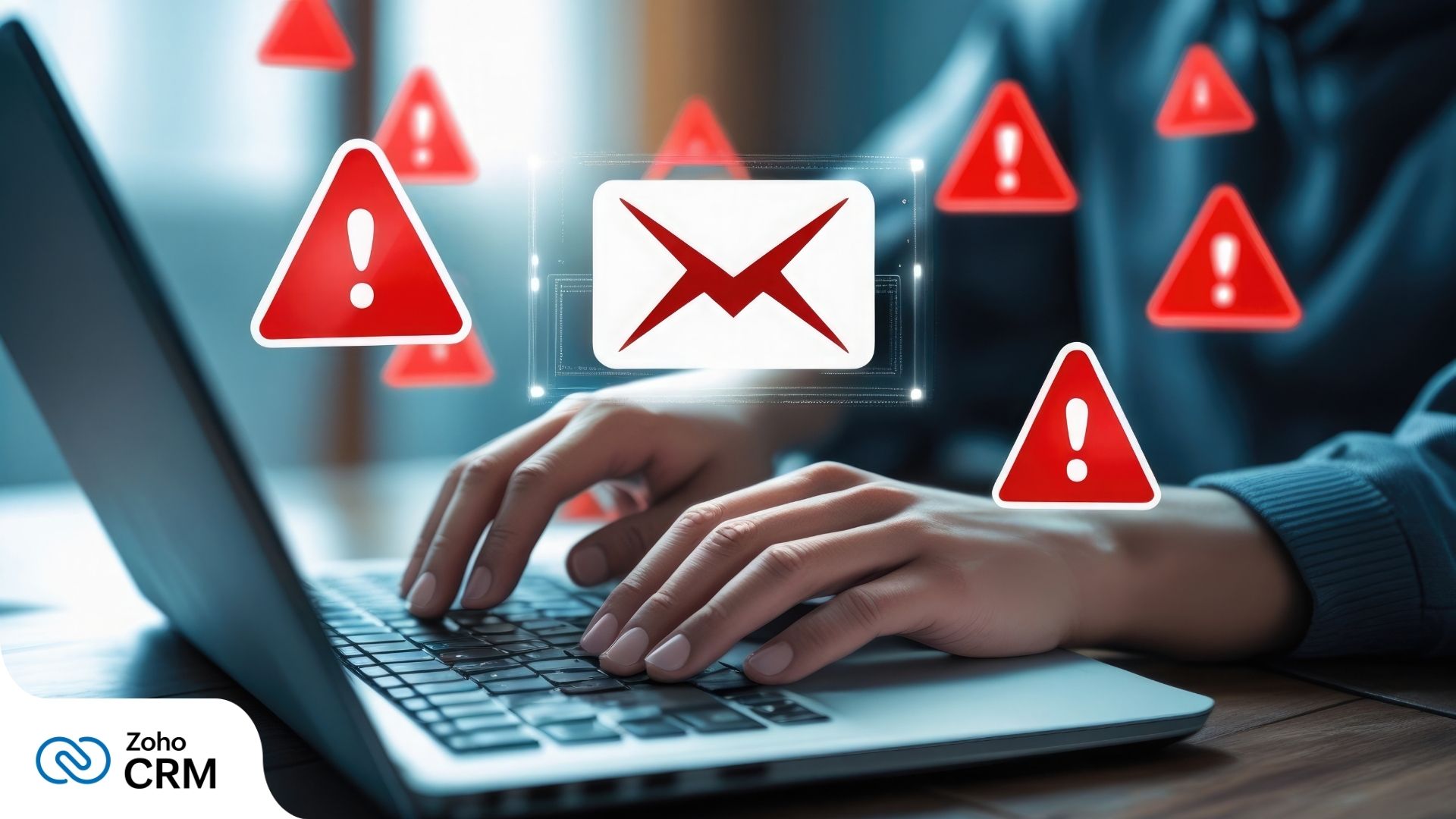3 reasons why sales forecasts fail and how to fix it
- Last Updated : July 10, 2025
- 412 Views
- 7 Min Read

Sales forecasting is often a sales leader's least favorite job. No matter how well-crafted, sales forecasts are inevitably wrong. This leads to shortfalls in predicted revenue, missing out on opportunities, and over or under stocked inventory.
The irony is that businesses only need three pieces of information to build a forecast: historical sales data, knowledge of current trends in the market, and an accurate estimate of the sales team's performance—all of which are easily available to sales leaders. So, what causes sales forecasts to fail? More importantly, how do you fix this situation?
The top reasons why sales forecasts fail
When numbers don't add up
Optimism is a great skill for a salesperson when it's used to persistently follow up on and nudge hesitant leads towards closure. However, optimism in the face of a customer going "no contact" for months, with no introduction to senior leadership or decision makers, and no response to your POC, is just not a good practice. When sales people optimistically hold on to stale deals, even if they know they may not convert, it inflates pipelines and projections. This leads businesses to believe they're set for greater wins, when in fact, they're not.
No one likes to admit that they've lost a deal. Sales people are no exception. Fear of failure and lost commissions can drive sales people to let stale deals remain in the pipeline long after they've gone stale. While this does boost the pipeline, it also inflates the win rate. That is, this makes it appear as if sales people are winning most of the deals in the pipeline. As a domino effect, this can lead to inflated predictions as the historical data itself is inherently flawed.
Blunders in bookkeeping
If you haven't come across a sales person using his own "personal CRM"—usually a user-owned spreadsheet—chances are, you're running a unicorn sales team. The fault isn't with a lack of tools, rather the use of too many tools.
Gartner claims that an average organization uses about five sales technology tools for its day-to-day operations. This means that sales people have to jump through half a dozen tools every day and manually enter data in each one of those tools whenever activity is observed in any of their accounts. To minimize data entry efforts, sales people simply store deal data on a local spreadsheet, hoping to transfer it to the CRM later, which sometimes doesn't happen. As a result, decision-makers have a skewed vision of the deals in the pipeline, ultimately leading to skewed forecasts.
Bad data leading to bad decisions
CRM systems can accrue bad data over time. Customer information could change; the business may fail to engage in periodic data clean up practices; or simply because sales people entered the data wrong. However, subjective emotions have a formidable impact on the quality of sales data in CRM systems and, in turn, the quality of sales forecasts.
For instance, building the entire relationship around a single point of contact in the company can mean stronger relationships. However, when the contact moves on to a different role or company, sales people will be left without a trusted liaison at the other end, putting an end to that relationship. When this subjectivity finds its way into your CRM data, projections built on such data can turn out to be over inflated or fall flat.
Deploying inconsistent logic in grading deals in the pipeline inflates the win rate. Sales people working for different regions, or sales people reporting to different managers, might follow different sets of rules. For instance, one team might consider five positive interactions with a lead as a qualifier for a promising deal, while another team might consider delivering a demo as a qualifier. While neither logic is wrong, the inconsistency can trickle into forecasts and skew plans.
For convenience, sales teams use AI-based algorithms to score deals on the pipeline to help prioritize imminent deals. However, most of these algorithms themselves may be inherently flawed. For instance, when deals progress through the pipeline, each stage is awarded one score automatically, regardless of the importance of that stage in deal conversion. However, not all stages are equal. Unless the algorithms are adjusted to grade stages based on their importance, any forecasts built using this data tend to be misleading.
How to fix these issues
To cushion the impact of poor sales forecasts, sales leaders give their forecasts a reality check, that is, trim the numbers on forecasts. DRIs for critical areas, such as sales performance, revenue, productivity, or process effectiveness, prepare yearly forecasts in their focal areas while the sales leader trims these numbers down to keep them realistic. Arguably effective in arriving at reliable forecasts, this method is still not the silver bullet for building reliable forecasts. There are other more effective techniques that can help derive reliable and accurate sales forecasts. Here are some of those.
Move away from top-down forecasts and embrace bottom-up forecasts
Forecasts built by sales leaders are based on available numbers, figures, goals, and objectives. On the other hand, forecasts built by sales people themselves are based on ground facts and first-hand information straight from the customers. These forecasts tend to be more reliable and grounded in reality when compared to overarching forecasts. Sales leaders can simply harmonize them to get cohesive forecast reports for the entire organization.
Bottom-up forecasts create accountability and responsibility, and give staff from all levels a seat at the decision-making table, making them feel involved. Hiccups that do arise in these forecasts can be ironed out later. Adjustments can be made to the forecasts for subsequent quarters so the yearly forecasts turn out solid. Within a few quarters, your team will learn to build accurate forecasts.
As an added benefit, this would eliminate faulty bookkeeping practices amongst the ground level staff. If sales people are the ones building forecasts for themselves based on their own data, withholding deal information about in-progress deals or optimistically holding onto stale deals won't work in the favor.
Sales leaders can install mechanisms to reward accurate forecasts to promote efficient bookkeeping and accurate forecasting.
Break down overarching forecasts into forecasts for contributing factors
Sales leaders build overarching forecasts for the entire organization, and then break them down to each region, team, or business unit. For instance, when building revenue forecasts, sales leaders forecast the overall revenue for the organization and then break it down to each region or team. A better option is to break this down further and create forecasts for contributing factors that lead to sales—such as customer interactions, value engagement, or sales activity.
Analyze historical data for contributing factors and measure its direct impact on outcomes. For instance, measure how many demos or 1-on-1s it takes to attain a specific amount. Now forecast how many demos it would take to attain a desired revenue and set the target revenue. Go deeper and set stage-wise targets for each activity and its conversion based on targeted revenue.
Standardize steps, stages, processes, and logic
The first step to fix your forecasts is to fix inherent flaws in your system, that is, fixing the inconsistencies. Determine the processes that lead to sales and deploy algorithms to reward team members for sales as they move through the process. Configure as many process flows as you need and book them into your system. Continuously track how leads move through various stages and become customers, and keep adding to your list.
In each process, determine stages or steps that customers might take towards conversion. Given that no two customers are alike, establish segments and processes for each segment. Give room for flexibility but account for all changes in the process map. This ensures every single customer journey is accounted for, tracked, and tagged in your system. For instance, identify the final stage in each process that leads to conversion. Specify your algorithms to award only these stages as the final stage for conversion. In this way, you eliminate biases and keep your algorithms free from adopting multiple definitions.
Review commitment and forecasts for each sales representative
Between forecasts and actual commitment to the forecasts, there may be hidden gaps. The best way to find and fix them is to track the performance of each sales representative against their forecasts. This will shed the spotlight on those who are cushioning the impact of bad deals—deals remain in the same stage in the pipeline for more than a quarter—and those who are intentionally withholding deals—when deals suddenly appear in your sales pipeline right before conversion. These practices will ensure sales folks declare all deals accurately in the CRM, which will contribute to the accuracy of future forecasts.
Test, measure, review, iterate
Complicated methods, tools, and techniques to test the accuracy of forecasts have limited applicability and don't deliver long-lasting results. A simpler method is to set up forecasts, measure the outcome, and then make changes to the forecasting models as needed to achieve accuracy. As a prerequisite, prioritize finalizing the product market fit, market potential, pricing points, market penetration rate, seasonality, and trends that match your audience, product portfolio, and revenue objectives.
Conclusion
Sales leaders can have the best tools, technology, and teams, and yet churn out predictions that are grossly inflated or underwhelming. You need accurate and adequate sales data for reliable forecasting and analysis. The key to achieving this is to train your people to ensure data in the CRM is clean, adequate, accurate, reliable, and based on facts rather than gut instinct. Hold your team accountable. Reward those who report accurately and covertly discourage those who are rigging your numbers.
Finally, you need a structured sales forecasting strategy and a sales forecasting application that augments it well. This strategy should account for potential issues that might crop up and rely only on statistics to churn out reliable forecasts.


